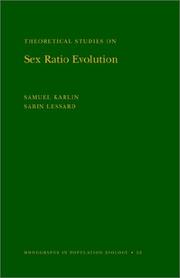| Listing 1 - 1 of 1 |
Sort by
|

ISBN: 0691084122 069121011X Year: 1986 Publisher: Princeton, NJ : Baltimore, Md. : Princeton Univ. Pr., Project MUSE,
Abstract | Keywords | Export | Availability | Bookmark
 Loading...
Loading...Choose an application
- Reference Manager
- EndNote
- RefWorks (Direct export to RefWorks)
This book deals with a key area of population genetics: the ratio of the sexes in a population, or the allocation of resources to male versus female reproductive function. Samuel Karlin and Sabin Lessard establish the formal theoretical aspects of the evolution of sex ratio within the constraints of genetic mechanisms of sex determination. Their results generalize and unify existing work on the topic, strengthening previous conceptions in some cases and, in other instances, offering new directions of research.There are two main approaches to understanding the causes and effects of sex ratio. One approach focuses on the optimization and adaptive functions of sex allocation, while the other emphasizes the consequences of genetic sex determination mechanisms. In discussing the utility of these two approaches, Professors Karlin and Lessard examine the principal sex-determining mechanisms and facts involved in sex ratio representations, the various genetic and environmental factors that contribute to adaptive sex expression, and the evolution of sex determining systems and controls. From a population genetic perspective, the authors derive evolutionary properties in support of the high incidence of 1:1 sex ratio in natural populations and investigate the conditions that can explain the occurrence of biased sex ratio.
Sex Ratio --- ESS. --- Perron-Frobenius theory. --- absolute linkage. --- biased sex ratios. --- central equilibrium. --- female heterogametry. --- gradient matrix. --- hermaphroditism. --- inbreeding. --- incompatibility models. --- local mate competition (LMC). --- male heterogamety. --- multilocus sex determination. --- parental expenditure (investment). --- pollen elimination. --- sib mating. --- symmetric equilibrium. --- two-sex viability models. --- underdominance. --- zygote elimination.
| Listing 1 - 1 of 1 |
Sort by
|

 Search
Search Feedback
Feedback About UniCat
About UniCat  Help
Help News
News